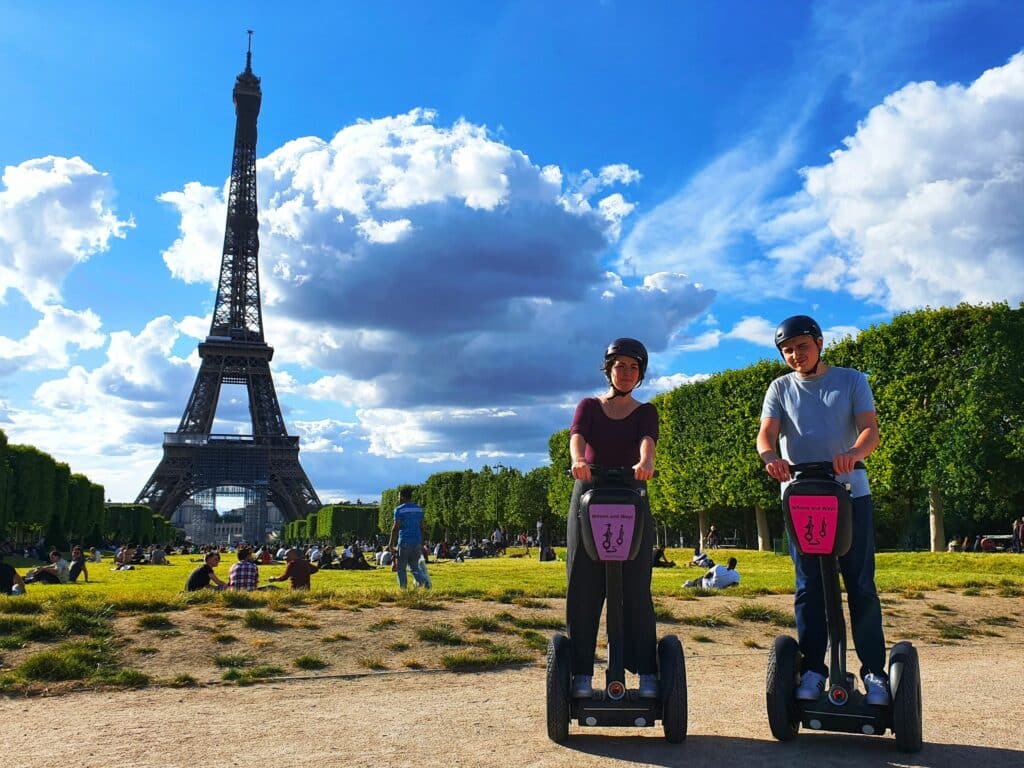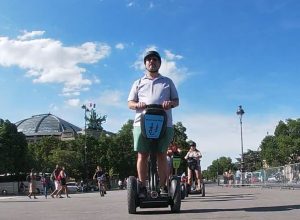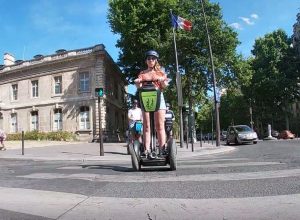Paris Express Tour by Segway
- Duration : 1h30
- Price : from 39€/pers.
- 12 points of interest
- Guide in english
Wheels and Ways
Segway Tours in Paris

No time to lose. If you want to see a lot of Paris in a short time, this is THE tour. 12 major points of interest and 5 km of Segway in 1,5 hour.
Visit the following 12 Parisian monuments: Eiffel Tower, Champ de Mars, Lavirotte building (Art Nouveau), Russian Orthodox Church, Alma Bridge, Quais de Seine, Alexander 3rd bridge (the ornate bridge), Petit and Grand Palais, Jeff Koons (Bouquet of Tulips), Invalides and the Military School.
Disclaimer: the purpose of this Express tour is to show 12 beautiful sites in Paris in a very short time frame (1 hour and 30 minutes!). During this 5 km Segway tour, we will take pictures and give you a quick overview of the monuments. If you want to have a detailed presentation of the monuments and more facts about Paris, we recommend our 2.5 hour guided tour “the Amazing Paris Segway tour by Segway“



15 minutes
Après une rapide formation à la conduite d’un gyropode (15 minutes), vous êtes sur votre Segway et prêt pour votre balade dans Paris à la découverte de ses monuments !
Etape 1
Un dernier regard vers l’élégante Ecole Militaire (construite en 1751 sous la conduite de Ange-Jacques Gabriel, l’architecte qui a également réalisé le petit Trianon à Versailles) et nous filons vers la Tour Eiffel.
Etape 2
C’est l’œuvre de l’architecte Jean-Michel Wilmotte également auteur de l’Eglise Orthodoxe Russe. Depuis 2021 le Grand Palais éphémère accueille les grands événements traditionnellement organisés au Grand Palais, fermé pour travaux jusqu’en 2026. Il accueillera les compétitions d’escrime pour les Jeux Olympiques de Paris 2024.
Etape 3
Carrousel du Champs-de-Mars : un peu plus loin sur notre gauche, le Carrousel du Champs-de-Mars datant de 1913. Dernier manège parisien fonctionnant à l’énergie humaine ! C’est la manivelle au centre du manège qui fait tourner les chevaux de bois d’origine, sculptés par les frères Limonaires.
Etape 4
Nous traversons le Champ de Mars, l’endroit idéal pour un arrêt photo « Tour Eiffel ». Vous pouvez la pincer ou la porter (sur votre Segway – si, si), la Dame de Fer ne s’en émouvra pas, elle en a vu d’autres depuis l’exposition universelle de 1889, elle qui devait être démontée au bout de 20 ans !
Etape 5
Nous filons sur notre Segway, et nous voilà au n°29 avenue Rapp, devant un étonnant immeuble Art Nouveau construit en 1901 par l’architecte Jules Lavirotte. Saurez-vous découvrir la symbolique de la porte d’entrée ?
Etape 6
Avançons au bout de l’avenue Rapp vers un petit bout de Russie à Paris, où se situent le Centre spirituel et culturel orthodoxe russe ainsi que la cathédrale de la Sainte-Trinité. Comme une ambassade, l’ensemble est un territoire Russe.
Etape 7
Nous continuons vers le pont de l’Alma (et son Zouave). Nous apercevons la Flamme de la Liberté, réplique grandeur nature de la flamme de la Statue de la liberté offerte par le Herald Tribune en 1989. Depuis 1997, la flamme est devenue le monument du souvenir de la princesse Diana (Diana memorial).
Etape 8
Nous empruntons la piste cyclable des Quais de Seine et nous nous dirigeons vers 3 monuments érigés à l’occasion de l’exposition universelle de 1900 : le Pont Alexandre III, le Petit Palais et le Grand Palais.
Etape 9
C’est le premier pont parisien à franchir la Seine d’une seule arche.
Etape 10
De style classique, il fut construit par l’architecte Charles Girault et est fidèle à sa vocation originelle de musée des Beaux-Arts de la ville de Paris (gratuit, fermé le lundi).
Etape 11
Accueille des manifestations culturelles temporaires. A noter que sa verrière (6000 tonnes d’acier et 2000 tonnes de verre) fait le même poids que la Tour Eiffel !
Etape 12
Dirigeons-nous désormais vers l’hôtel des Invalides. Sa construction fut ordonnée par Louis XIV en 1670 pour y accueillir ses blessés de guerre (jusqu’à 10 000 simultanément). Sous le dôme réside le tombeau de Napoléon.
Etape 13
Félicitations, vous venez de terminer votre Tour Express de Paris en Segway. Depuis l’hôtel des Invalides, nous regagnons le Champ de Mars pour d’ultimes photos en Segway bien méritées devant la Tour Eiffel 
1) 100% French smiling guides (and speaking English…Yes, we can 😊 !)
2) Our guides are experienced and licensed (see the team and « Segway Certified Instructor Licences » of Florian and Emmanuel)
3) We are the 1st Segway Tour Operator in Paris on TripAdvisor
4) Tour can go ahead with just one person and last minute Segway tours are possible!
5) Safety and user experience are our first concern: group of 9 people maximum per guide and off we go, nice and easy 😊
6) Itinary is 100% in compliance with the Personal Motorised Transporters French decree dated the 23rd of October, 2019
7) Many photo opportunities on route.
8) We do the tour whatever the weather is…
9) and we provide, if necessary, raincoat, windbreaker, fleece jacket. Everything is included in the price.
10) You have never been on a Segway and you want to test the machine before booking a tour? Just send us an email to book your 15-minute free trial !
/!\ For the health of mother and child, Segway tours are prohibited for pregnant women.
Our “public” Segway guided tours are open to people aged at least 14 years old.
For 12 and 13 year old children, we ask parents to book a “private” ride (or to contact us).
French Law # 2019-1082 of October 23, 2019 stipulates that the use of personal motorized transport equipment is strictly prohibited for children under 12 years of age.
Wear comfortable and closed shoes (avoid flip-flops).
Arrive a few minutes early so we can get to know each other 🙂
You can privatize your Paris Segway Tour on the day and time of your choice. Package of €316, then €79 per additional person (4 people minimum). This Private Tour lasts a minimum of 1h30 and a maximum of 2h30 to suit your wishes.
The privatization of your ride is necessary for any participant from 12 to 13 years old.
…is also:
– sharing a friendly or a family moment during holidays, for a stag / hen party or for a birthday party !
– a fun way to discover Paris and its main monuments
– an original tour on a high-tech machine (the Segway) everybody will enjoy !
– an unexpected way to learn French… with our 100% French (SMILING) English speaking guides !
– a central starting and finishing point. We meet at Place Joffre (at the foot of Marshal Joffre’s equestrian statue, facing the main entrance of the military school). The closest Metro Station is « La Motte Piquet Grenelle » (Métro numbers 6, 8 or 10) and take the Exit « Avenue de Suffren ». It’s 7-minute walk to the Eiffel Tower and there are also many cafés and restaurants in the neighbourhood.
Each Segway tour has its specificities and allows you to discover a different side of Paris.
Our other 2 or 2.5 hour Segway guided tours:
The Amazing Paris tour (8km route, Eiffel Tower, Orsay Museum…)
Paris by Night (discover the illuminated monuments of Paris)
Sunrise Paris Tour (to see Paris with (almost) no Parisians, and to segway on the empty Champs-Elysées avenue !)
Paris Street Art tour (to discover the modern 13th district of Paris and its beautiful murals)